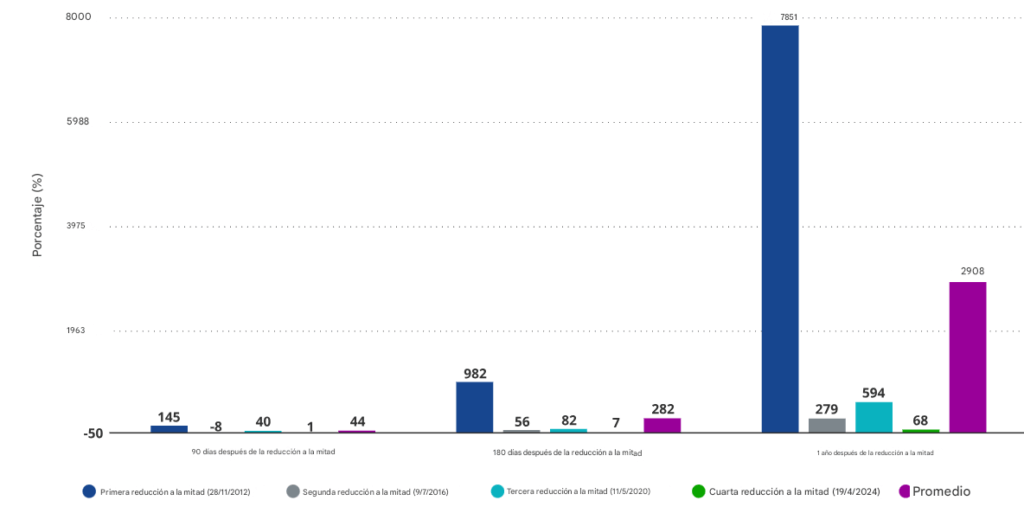The Vaneck investment firm reaffirmed its upward thesis on Bitcoin (BTC), highlighting a combination of structural and macroeconomic factors that, in their opinion, consolidate the digital asset as an alternative superior to gold as a reserve of value.
In your analysis entitled “The investment case for Bitcoin”the company holds that the intrinsic characteristics of Bitcoin, added to a growing institutional and technological adoption, They reinforce their long -term potential against precious metal.
The report underlines that Bitcoin’s limited issuance, with a maximum of 21 million units, It establishes a scheduled shortage that could boost its price over time.
This supply limit is also reinforced by “halving” events, which in half reduce the emission rate of new bitcoin approximately every four years. The most recent reduction occurred in April 2024 and previous cycles show that these events usually precede periods of significant price appreciation.
Bitcoin’s fourth halving originated on April 19, 2024, at the height of block 840,000. After that episode, The bitcoin mine reward was reduced to 3.125 BTCcurrently equivalent to USD 350,000.
In the following graph provided by Vaneck you can see the increase in Bitcoin’s performance after 90 and 180 days, as well as a year after the last halvings.


Coverage against inflation
From a monetary perspective, Vaneck contrasts the anti-inflationary architecture of Bitcoin with the unprecedented expansion of the supply of Fíat money that followed the Covid-19 pandemic.
This expansion eroded the purchasing power of national currencies, while Bitcoin, not being subject to decisions of central banks or fiscal policies, acted as coverage against inflation.
The above is reinforced with the fact that, Since 2020, Bitcoin has increased by 1,465%moving from the $ 7,700 at the beginning of that year, to the current USD 115,000, in a clear upward trend.
In contrast, the dollar index has had intense fluctuations and does not accumulate, at the present time, some remarkable yield. In January 2020, the DXY was in 98. And this Monday, August 4, 2025, it is exactly the same. However, in Interín there were explosive and low -important increases.
Increasing adoption
On the other hand, the firm also highlights an important evolution in the adoption of Bitcoin from its inception to the present. Initially limited to a small group of technological users, the use of Bitcoin has grown remarkably, the company suggested.
Vaneck notice the development of accessible wallets, efficient exchange platforms and an infrastructure that allows daily use. This evolution has been key to incorporating both retail and institutional users, they said.
Regarding corporate interest, the document shows that about 196,000 million dollars in Bitcoin are now under the custody of funds quoted in the stock market (ETF), governments and public and private companies. This growth in institutional tenure is interpreted by Vaneck as A sign of consolidation of the asset as a relevant part in diversified wallets.
Indeed, since January 2024, when the United States Stock Exchange and Securities Commission approved the Bitcoin ETF negotiation in cash; Corporate entities have been introduced directly into the ecosystemto the point in which they influence the price of BTC in the market, as cryptootics has reported.
Currently, ETF They control 1.3 million bitcoin, equivalent to 6.5% of the total currency supply. In addition, BTC’s daily purchases and sales are massive, With hundreds of millions of dollars in Bitcoin negotiating daily Through these instruments. This can be seen in the following Sosovalue chart.


The report also identifies technical developments that can accelerate future adoption. One of them is the expansion of second -layer solutions such as Lightning Networkwhich allow payments with faster speed and lower costs than the main network.
Vaneck also highlights the potential of the RGB protocol, which allows you to issue and manage digital assets on the Bitcoin network, including actions, bonds, real estate or other cryptocurrencies. This type of innovations opens new pathways of use and diversification on the same infrastructure, which could expand the role of Bitcoin within the financial ecosystem, says the company.
The same but different
Faced with these advances, comparison with gold becomes central. Although both assets share properties such as scarcity, Vaneck identifies specific advantages in favor of Bitcoin.
One of them is its divisibility: while physical gold has limitations to fraction in small transactions, Bitcoin can be divided by up to one hundred million unitswhich facilitates payments of any size.
Another point highlighted by the firm is transparency. All Bitcoin transactions are public and verifiable in real time through their network. This traceability, according to Vaneck, significantly reduces the risk of manipulation or fraud.
In contrast, gold trade is often done without detailed public records on buyers, sellers or prices, which introduces uncertainty and hinders the validation of its authenticity.
At the historical performance level, the report presents figures that reinforce Bitcoin’s idea as a high profitability asset. According to data as of June 30, 2025, The return accumulated in ten years exceeds 35,000%. Even in shorter horizons, the results are notable: 122% in one year, 99% in three years and more than 1,200% in five years.
And although the high volatility of BTC is recognized, Vaneck argues that a moderate assignment in traditional portfolios (mostly composed of actions and bonds) can improve the performance adjusted to risk.
From a vision of investment strategy, Vaneck states that Bitcoin can play a relevant role as an unbroken active. This, making it clear that, in environments of inflation or expansive monetary policies, where the value of the Fíat money is diluted, Bitcoin offers an alternative refuge that does not depend on central authorities or is affected by political measures.
The analysis concludes that, although gold has historically been a value shelter, its limitations in divisibility and transparency could subtract competitiveness against Bitcoin in the current context. With an expanding infrastructure, diversified and growing cases of use and institutional support, Vaneck considers that Bitcoin is well positioned to gain prominence as a value reserve in the next decades.


